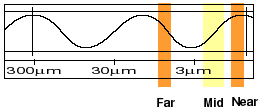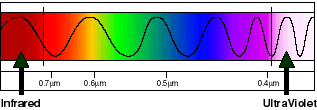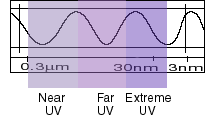


Electromagnetic radiation is energy, which is sent through free space or through a material medium in the form of electromagnetic waves. An electromagnetic wave is a transverse wave in that the electric field and the magnetic field are perpendicular to each other as well as to the direction of the wave movement, at any point or time in the wave. However, electromagnetic waves are not affected by normal electric or magnetic fields.
In space, electromagnetic waves travel at the speed of light (299,792,458 m per second).
Electromagnetic waves have propeties similar to other forms of wave such as reflection, refraction, diffraction and interference.
A quantum of electromagnetic energy is called a photon. Electromagnetic radiation can be thought of as a stream of photons.
Electromagnetic waves are familiar to us in many ways. There are different kinds of electromagnetic waves:
Light, microwaves, infrared, ultraviolet, gamma-rays, x-rays and radio transmissions.
They are all the same kind of wavy disturbance that repeats itself over a distance called the wavelength.
 Radio waves: These have the longest wavelengths. They can be longer than a football field or as short as a football. Radio waves do more than just bring music to your radio, they also carry signals for your television and mobile phones. The antennae on your television set receives the signal, in the form of electromagnetic waves that are broadcasted from the television station, it is then displayed on your television screen. Cellular phones also use radio waves to transmit information. These waves are much smaller that TV and FM radio waves.
Radio waves: These have the longest wavelengths. They can be longer than a football field or as short as a football. Radio waves do more than just bring music to your radio, they also carry signals for your television and mobile phones. The antennae on your television set receives the signal, in the form of electromagnetic waves that are broadcasted from the television station, it is then displayed on your television screen. Cellular phones also use radio waves to transmit information. These waves are much smaller that TV and FM radio waves.
Radio telescopes are dishes made out of conducting metal that reflect radio waves to a focus point. Because the wavelengths of radio light are so large, a radio telescope must be physically larger than an optical telescope to be able to make images of comparable clarity. Radio telescopes look toward the heavens at planets and comets, giant clouds of gas and dust, and stars and galaxies. By studying the radio waves originating from these sources, astronomers can learn about their composition, structure, and motion. Radio astronomy has the advantage that sunlight, clouds, and rain do not affect observations.
 Infrared waves: We often think of this as being the same thing as 'heat', because it makes our skin feel warm.
Infrared waves: We often think of this as being the same thing as 'heat', because it makes our skin feel warm.
In space, IR light maps the dust between stars. Infrared light has a range of wavelengths, just like visible light has wavelengths that range from red light to violet.
Since the primary source of infrared radiation is heat or thermal radiation, any object which has a temperature radiates in the infrared. Even objects that we think of as being very cold, such as an ice cube, emit infrared. When an object is not quite hot enough to radiate visible light, it will emit most of its energy in the infrared. For example, hot charcoal may not give off light but it does emit infrared radiation which we feel as heat. The warmer the object, the more infrared radiation it emits.
To make infrared pictures we can use special cameras and film that detect differences in temperature, and then assign different brightnesses or false colors to them. This provides a picture that our eyes can interpret.
 Visible waves: This is the part that our eyes see. Visible radiation is emitted by everything from fireflies to light bulbs to stars, also by fast-moving particles hitting other particles.
Visible waves: This is the part that our eyes see. Visible radiation is emitted by everything from fireflies to light bulbs to stars, also by fast-moving particles hitting other particles.
Visible light waves are the only electromagnetic waves we can see. We see these waves as the colors of the rainbow. Each color has a different wavelength. Red has the longest wavelength and violet has the shortest wavelength.
When all the waves are seen together, they make white light. When white light shines through a prism or through water vapor like this rainbow, the white light is broken apart into the colors of the visible light spectrum.
Cones in our eyes are receivers for visible light waves. The Sun is a natural source for visible light waves and our eyes see the reflection of this sunlight off the objects around us. The color of an object that we see is the color of light reflected. All other colors are absorbed. Light bulbs are another source of visible light waves.
There are two types of color images that can be made from satellite data - true-color and false-color. It is true that we are blind to many wavelengths of light. This makes it important to use instruments that can detect different wavelengths of light to help us to study the Earth and the Universe. However, since visible light is the part of the electromagnetic spectrum that our eyes can see, our whole world is oriented around it. And many instruments that detect visible light can see father and more clearly than our eyes could alone. That is why we use satellites to look at the Earth, and telescopes to look at the Sky!
 Ultraviolet waves: The Sun is a source of ultraviolet (or UV) radiation, because it is the UV rays that cause our skin to burn! UV light causes our skin to create melenin, which protects against the harmful UV rays. It is the melanin that gives us a sun-tan. However, some people's skin is not efficient in producing it and their skin burns. UV rays can also produce cancerous cells.
Ultraviolet waves: The Sun is a source of ultraviolet (or UV) radiation, because it is the UV rays that cause our skin to burn! UV light causes our skin to create melenin, which protects against the harmful UV rays. It is the melanin that gives us a sun-tan. However, some people's skin is not efficient in producing it and their skin burns. UV rays can also produce cancerous cells.
Stars and other "hot" objects in space emit UV radiation. Astronomers have to put ultraviolet telescopes on satellites to measure the ultraviolet light from stars and galaxies - and even closer things like the Sun! We can study stars and galaxies by studying the UV light they give off - but we can also study the Earth.
 X-rays: Your doctor uses them to look at your bones and your dentist to look at your teeth. Hot gases in the Universe also emit X-rays.
X-rays: Your doctor uses them to look at your bones and your dentist to look at your teeth. Hot gases in the Universe also emit X-rays.
When you get an X-ray taken at a hospital, X-ray sensitive film is put on one side of your body, and X-rays are shot through you. X-rays pass through less dense materials such as skin tissus more easily than through denser materials such as bone. This is why your bones show up more clearly.
At a dentist, the film is put inside your mouth, on one side of your teeth, and X-rays are shot through
your jaw. You can't feel X-rays, because your bones and teeth are dense and absorb more X-rays then your skin does. Silhouettes of your bones or teeth are
left on the X-ray film while your skin appears transparent.
We use satellites with X-ray detectors on them to do X-ray astronomy. In astronomy, things that emit X-rays are like the dentist's X-ray machine, and the detector on the satellite is like the X-ray film. Many things in space emit X-rays, among them are black holes, neutron stars, binary star systems, supernova remnants, stars, the Sun, and even some comets!
The Earth can produce aurora high in
the Earth's atmosphere. These aurora are caused by charged particles from the Sun. X-rays have smaller wavelengths and therefore higher energy than ultraviolet waves.
We usually talk about X-rays in terms of their energy rather than wavelength. This is partially because X-rays have very small wavelengths. It is also because X-ray light tends to act more like a particle than a wave. X-ray detectors collect actual photons of X-ray light - which is very different from the radio telescopes that have large dishes designed to focus radio waves! The x-rays themselves come from the electrons in an atom.
The Earth's atmosphere is thick enough that virtually no X-rays are able to penetrate from outer space all the way to the Earth's surface. This is good for us.
 Gamma-rays: Radioactive materials (some natural and others made by man in things like nuclear power plants) can emit gamma-rays. Gamma rays are the energy that is produced by the nucleus of an atom.
Gamma-rays: Radioactive materials (some natural and others made by man in things like nuclear power plants) can emit gamma-rays. Gamma rays are the energy that is produced by the nucleus of an atom.
Big particle accelerators that scientists use to help them understand what matter is made of can sometimes generate gamma-rays.
But the biggest gamma-ray generator of all is the Universe! It makes gamma radiation in all kinds of ways.
Gamma-rays extremely small wavelengths and the most energy of any other wave in the electromagnetic spectrum. These waves are generated by radioactive atoms and in nuclear explosions. Gamma-rays can kill living cells, a fact which medicine uses to its advantage, using gamma-rays to kill cancerous cells.
Gamma-rays travel to us across vast distances of the universe, only to be absorbed by the Earth's atmosphere.
The first gamma-ray telescope, carried into orbit on the Explorer XI satellite in 1961, picked up fewer than 100 cosmic gamma-ray photons!
Unlike optical light and X-rays, gamma rays cannot be captured and reflected in mirrors. The high-energy photons would pass right through such a device. Gamma-ray telescopes use a process called Compton cattering, where a gamma-ray strikes an electron and loses energy, similar to a cue ball striking an eight ball. By solving the mystery of gamma-ray bursts, scientists hope to gain further knowledge of the origins of the Universe, the rate at which the Universe is expanding, and the size of the Universe.
 Microwave: Microwaves have wavelengths that can be measured in centimeters!
Microwave: Microwaves have wavelengths that can be measured in centimeters!
We may think that radio waves are completely different to gamma-rays. They are produced in very different ways, and we detect them in different ways. But they are not really different things. Radio waves, visible light, X-rays, and all the other parts of the electromagnetic spectrum are fundamentally the same thing. They are all electromagnetic radiation.